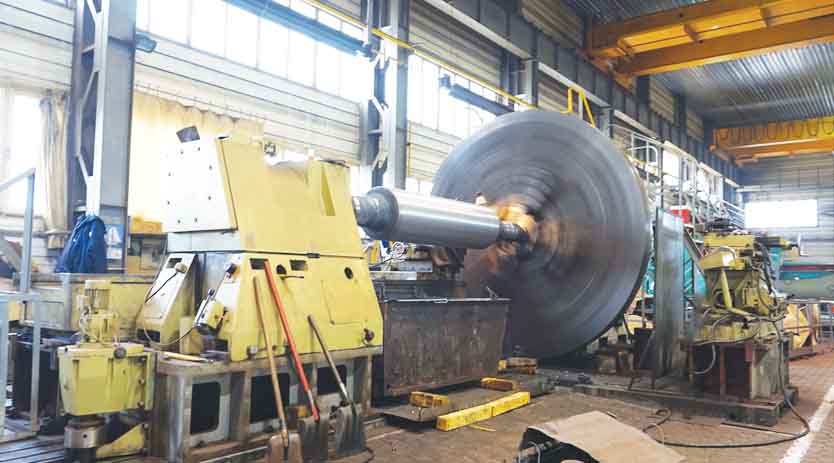Cooling and Ventilation solutions to transform smart manufacturing
March 1, 2023 6:36 pm
Sharing expertise about cooling solutions and material handling for warehouse automation, industry experts talk about advancements in cooling, cold chain logistics, warehouses and the environment in manufacturing facilities.
Manufacturing comprises three major stages, namely processing, packaging, and storage. And looking at the intricacy of the industries, quality air solutions are required at all three stages. Integration of Industry 4.0 is a breakthrough advancement in the HVAC industry. Latest technologies such as AI, AR, IoT, robotics, cloud computing, etc. are vested a lot of importance on ‘smart manufacturing’ or ‘smart factories’.
Robots are taking over warehouse jobs with increasing volumes; hence they have a lot of space to change the warehouse scenario. Automation, mobile robots, and new skills adoption are emerging as new patterns for the supply chain. A cold supply chain involves the logistical handling of temperature-sensitive products and pharmaceuticals at various endpoints during the chain. Global e-commerce sales grew from just 5 percent of retail sales earlier to around 20 percent today.
The Indian cold chain logistics sector is expected to reach approx. $782 billion by 2030 due to increased refrigerated warehouses and pharmaceutical growth. The logistics tracking instruments and delivery software technologies evolve to handle all temperature-sensitive goods at transit points of shipments. The drones in supply chain management may enable the ‘zero-error’ warehouse. As per studies, this may lead to data collection time savings of up to 50 to 80 percent.
Untapped opportunities
The importance of quality air is of prime importance. There is a clear shift towards multipurpose storage and value-added services covering end-to-end requirements. Gubba Kiran, CEO, Gubba Cold Storage, says that untapped opportunities in Indian cold chain logistics are the foreign direct investment & enhancement of public-private relationships to fuel the industry’s growth. If looked at through the lens of technology, there is a lot of scope for development in this sector.
Taking a constructive view, Vikas Taneja, Business Chief, Cold Chain, Panasonic Life Solutions India, categorically states, “To safely stock, preserve and distribute perishable products with minimal wastage, we need a mature cold chain. Even though there is a lot of focus from the Government of India towards cold chain development and continuous improvement, the Indian cold chain industry can still be considered nascent since there are considerable gaps in existing infrastructure against the needs. Food waste is highly concerning due to the need for appropriate and effective cooling.
Installing efficient HVAC systems and desiccant dehumidifiers at various manufacturing stages can increase production efficiency, says Vasudha Jajoo Pahwa, Marketing Strategy, Pahwa Group. For example, the cold chain inhibits the prospects of frost formation on the evaporators and the building-up of ice on the cooling coils. Overall, the HVAC system ensures seamless continuity of processes as it allows smooth conveyance of materials from one end to another.
If we see the wastage, there is much-untapped potential with future-ready technologies. From the perspective of wastage, Suunil Dabral, Senior Vice President & Business Head, Godrej Körber, states, “One of the major causes for food wastage is a lack of relevant infrastructure in the country followed by the lack of awareness.” The country’s 7500 cold stores cover only 11 percent of the country’s perishable produce. Hence, the Indian logistics sector has much to catch up on in the cold chain infrastructure. An enormous scope of different cooling processes is required to maintain the cold chain without any break with temperature logging and complete visibility, with the help of growing IoT-based modern cold chain ecosystems.
Talking about investing, Vikram Murthy, Director, Univac Environment Systems, mentions, “At the Core of the dilemma rests the unwillingness to invest deeply into Cold Chains – because private sector investors, local Government bodies and Cooperatives have not acted as a unified collective – due to uncertainties of regular local farm produce.”
Developed nations have perfected this chain to yield high incomes. Sounding optimistic, Sunil says new opportunities are emerging around the last mile deliveries, i.e. delivering them fresh. This may include the various value-added services based on the delivery time duration for multiple customers. Vikas responded quickly, “Currently, the biggest challenge for quick online deliveries is to deliver small quantities on time while maintaining product integrity and quality. This needs efficient mid-mile and last-mile storage and delivery solutions.” Efficiency is required regarding running costs for climate-controlled storage and delivering the last mile.
Monitoring trends
Considering the heat problem intervening with the concentration of the employees and plaguing their productivity, industry players constantly seek economical cooling solutions. That provides a comfortable environment for working. Sensors and data loggers are essential components of the sensory network of a temperature-controlled environment. Various types of sensors, such as temperature sensors, humidity sensors, chemical indicators, and impact and tilt sensors, are used in this network. Temperature sensors sense the temperature at a specific location within a cold room, freezer room, refrigerator, or freezer unit.
According to the International Institute of Refrigeration (IIR), the demand for heat-sensitive health products such as drugs, vaccines, insulin, derived blood products, and oncology products are rising globally every year. Hence, the manufacturing and transporting of these drugs is the most critical phase in the cold chain due to the possibility of unforeseen environmental variations. Cold chain transportation is a temperature-controlled supply chain used in pharmaceuticals, healthcare, food & beverages, and chemicals. The increasing demand for temperature-sensitive drugs, rising demand for better food quality, surging need for reducing food wastage, and growing demand for generic drugs is anticipated to drive the market’s growth.
The temperature-sensitive monitoring market for transport is expected to grow at the highest CAGR during the forecast period. The growing focus on improving the supply chain efficiency of the fast-growing pharmaceuticals sector is also expected to contribute to the market’s growth. Data loggers are used throughout the cold chain to monitor the temperature of food, pharmaceuticals, chemicals, and other temperature-sensitive products.
Further, installing AC in large critical processes in manufacturing is complicated, expensive, and impractical. The effective cooling and ventilation solutions address the issues with its energy-efficient and cost-effective products that enhance the production efficiency of the facilities, says Ms. Vasudha. They curb the menace of poor IAQ by introducing clean, fresh air from outside to the building and simultaneously ensuring the continuous circulation of the air.
Automation and IoT-enabled technology
One of the major technological developments in the HVAC industry has been the move towards smart technologies using next-generation controls for optimising air quality and facilities performance. Better control over assets in warehouses is achieved using automation and cooling technologies. Warehouse automation aids efficient storage space utilisation, reduces wear and tear, increases reliability, and reduces operating costs. Sunnil points out that the degree of automation was a factor considered in the past. Still, now it is about the intelligence built into these machines to take calculated decisions based on predictive analysis, which is backed by a large amount of data generated in any warehouse. It will be worth an investment in incorporating IoT-based solutions for productive transformations, says Sunnil.
Expanding further, Ms. Vasudha deliberates that advanced technologies are instrumental in automating the various operations that troubleshoot, operate, and monitor processes. It is changing how the work is done by streamlining day-to-day activities and workflows on the shop floor. She said, “The technology is adept at making unified information-driven decisions in the factory environment with the help of real-time data and information.”
Technology must drive the innovation of efficient refrigeration and cooling systems powered reliably by a grid and renewable energy hybrid. The Transport refrigeration systems must have communication and no fail cooling systems on board. Extending further, Vikram remarks, Phase change materials, efficient onboard batteries to power twenty-four-hour refrigeration, EV transport, Scroll Based refrigeration systems – are each contributing to enhancing the reliability and efficiency of the refrigeration system. Moreover, storage owners should deploy IoT-enabled monitoring solutions like embedded sensors throughout the cold chain. These sensors collect data on environmental conditions and promptly send alerts via 4G/5G networks to ensure a coherent tracking network. The growing concerns about improving air quality will lead to advances in HVAC sensors. The advent of Integrated Industry 4.0 with IoT will lead to high demands for technology enhancements for productivity.
We have begun but have yet to master the radio frequency identification technology, infrared sensors, laser scanner information sensing equipment, modern communication technology, RFID and the IoT for Indian logistics, sums up Gubba.
Future insights
Green Value Chain Development, in its most basic form, seeks to improve the overall environmental sustainability of the entire shop floor by optimising air quality and the general environment. Due to the rampant environmental concerns, the HVAC industry has moved towards low carbon intensity, lesser fuel, and electricity, giving rise to the demand for energy-efficient equipment in the HVAC market. Moreover, discussing the importance of air quality, Pravin Rawool, AVP & Head – MEP Business, Godrej & Boyce said, “The increasing concerns for Air quality demand high-level filtrations along with comfortable cooling.”
Conclusively, evaporative coolers are energy recovery ventilators that are the ideal cooling and ventilation solutions for commercial warehouses, discerning the complex structure of warehouses. These also involve critical processes such as design specification, an assemblage of parts, processing of raw materials, etc., being carried out in the facility. Green construction or sustainable building design for new factories and manufacturing facilities is catching up firmly as more and more focus is towards going green and being more environmentally friendly. Nonetheless, the Indian government’s focus on improving energy efficiency and promoting sustainable cooling solutions in large spaces will provide further momentum to the industry.
Automation, HVAC installation and new technologies can improve control in warehouses, manufacturing facilities and factories. All said hitherto, the demand for a better working environment in commercial production facilities construes major opportunities for smart manufacturing to become the catalyst for social transformation in India.
Vasudha Jajoo Pahwa, Marketing Strategy, Pahwa Group.
“Installing efficient HVAC systems and desiccant dehumidifiers at various manufacturing stages can add to production efficiency.”
Gubba Kiran, CEO, Gubba Cold Storage Pvt. Ltd.
“Green Value Chain development, in its most basic form, seeks to improve the overall environmental sustainability of the entire chain by optimising linkages between players.”
Suunil Dabral, Senior Vice President & Business Head, Godrej Körber.
“If we see the wastage in the seafood segment – at least 30-40 percent- then the cold chain industry has much-untapped potential with future-ready technologies.”
Vikas Taneja, Business Chief, Cold Chain, Panasonic Life Solutions India.
“We need a mature environment for the cold chain to safely stock, preserve and distribute perishable products with minimal wastage.”
Kishor Patil, Country Head of Trane HVAC Business India and SAARC Markets, Trane Technologies.
“One of the major technological developments in the HVAC industry has been the move towards smart technologies using next-generation controls for optimising performance.”
Vikram Murthy, Director, Univac Environment Systems Pvt. Ltd
“Technology must drive the innovation of efficient cooling systems powered reliably by a grid and renewable energy hybrid.”
Pravin Rawool, AVP & Head – MEP Business, Godrej & Boyce.
“The increasing concerns for Air quality demand high-level filtrations along with comfortable cooling.”
Cookie Consent
We use cookies to personalize your experience. By continuing to visit this website you agree to our Terms & Conditions, Privacy Policy and Cookie Policy.


















